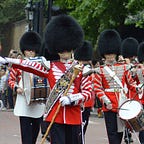20th Century Music —The Epitome of Trying to Define “Music”
Greetings, Medium readers!
Clare I. Percusión here to ponder with you all today about “What exactly is 20th Century Music?”
We’re talking Rock and Roll, right? Well, not quite….
When one thinks about 20th Century music, this may immediately bring to mind the musical genres of rock and roll, disco or pop music.
But the topic at hand today is in regards to the history of Western art music, often described as “classical music”. The different eras of Western art music include the Medieval era (or Middle Ages), the Baroque era, the Classical era, the Romantic era and finally, the 20th century era. But it is important to remember that these periods often overlap from one era to the next, there are no set boundaries.
The composers that you may know…
Many people may not be familiar with the broad array of compositional styles of 20th century Western art music. But I would imagine that some folks are familiar with the names of composers such as Gustav Mahler, Claude Debussy, Richard Strauss, Igor Stravinsky, and Aaron Copland. The music of some composers such as Mahler and Strauss played roles in both Romanticism while also dabbling into 20th century music. Many of their later works have compositional styles that sound like what one thinks of with the term “classical music”… there is still an orchestral sound but the music now has more dissonance.
And those composers who are not quite so “classical”…
But what about those composers who may have appeared to be on the fringes of classical music and compositional style… at least at the time they were composing their music. Well, I would propose that it is these composers who really contributed the most to 20th century Western art music. Why? Because they pushed the boundaries of defining what “music” is. How do we define what is music and what is not? Who gets to determine this? If I bang a bunch of pots and pans and write the notations on a musical score, does that count as music?
There were many 20th century composers who explored the bounds of music through new compositional methods: Arnold Schoenberg and his journey into atonality with his twelve tone technique; his students, Alban Berg and Anton Webern who continued to explore twelve tone music; Arvo Pärt and Philip Glass who composed music that embraced “minimalism”; and the electronic music of Edgar Varèse. This is admittedly a very brief list of the many composers of 20th century Western art music. There are also other compositional techniques that could be discussed such as the use of instruments in very unusual ways… as with the prepared piano.
The epitome of 20th century music… defining “music”
But rather than going into detail on compositional styles, I’d like to tell you what 20th century music represents to me. I would posit that 20th century music, especially the music that colors outside the lines, so to speak, is trying to answer a basic question: What is music?? And the contrasting idea of whether one can ever say that a compositional piece is not music?
Perhaps the best example would be John Cage’s composition, 4’33’’. In this composition, of which there are three movements, there is no musical notation and therefore no actual sounds for the musicians to make. They are to sit on the stage, hold their instruments for a period of four minutes and 33 seconds. There is complete silence. Or is there really? Will you hear the whir of the air conditioning, the persistent cough of a concert attendee, the ruffling of the music program? What point is Cage trying to make here? His premise is that “silence does not exist.” And that on the contrary, that what we do hear during the performance of 4’33’’ produce music at that moment in time… each performance of 4’33’’ is its own composition.
There are other fascinating 20th century works by the likes of George Crumb and György Ligeti. Crumb’s Black Angels, has haunting and screeching electronic strings. Perhaps not soothing music at all but Black Angels ultimately depicted the horrors and darkness of the Vietnam War as well as the fight of good versus evil. Ligeti describes his composition, Aventures, as “an imaginary stage action that is undefined as to content but precisely defined as to the emotions displayed” (as quoted in an Oxford Music online article by Paul Griffiths.) Aventures is truly a wild adventure in alterations in voice production and unusual instrumental sounds to portray an imaginary conversation but while clearly exhibiting emotions. But after listening to Crumb’s Black Angels and Ligeti’s Aventures, would one describe the pieces as “music”?
This is the exact question that I leave with readers. How do you define music? What is music? Can a composer’s creative work ever be said to not be “music”?
To help you weigh in on this, I have included some very interesting 20th century musical performances. Well, what do you think? Is each of these examples “music” to you?
John Cage’s Water Walk (1959)
John Cage’s 4’33’’ (1952)
György Ligeti’s Aventures (1962)
George Crumb’s Black Angels (composed for electric string quartet in 1970 at the time of the Vietnam War)… notice the unusual musical score as well.
